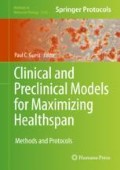Abstract
This chapter describes a protocol for proteomic profiling of the rat hippocampal proteome using a combination of liquid chromatography tandem mass spectrometry (LC-MS/MS) and data analysis to determine the cellular location of the identified proteins. In the example given, many of these proteins were localized in the plasma membrane and nucleus. These could be of interest in further studies of neurological and neurodegenerative disorders linked with hippocampal dysfunction, such as aging, major depression, and Alzheimer’s disease.
Access this chapter
Tax calculation will be finalised at checkout
Purchases are for personal use only
References
Budson AE, Solomon PR (2015) Memory loss, Alzheimer’s disease, and dementia: a practical guide for clinicians, 2nd edn. Elsevier, Amsterdam. ISBN-10: 9780323286619
Lashley T, Schott JM, Weston P, Murray CE, Wellington H, Keshavan A et al (2018) Molecular biomarkers of Alzheimer’s disease: progress and prospects. Dis Model Mech 11(5). pii: dmm031781. https://doi.org/10.1242/dmm.031781
Alzheimer’s Association (2016) 2016 Alzheimer’s disease facts and figures. Alzheimer Dement 12:459–509
Prince M, Wimo A, Guerchet M, Ali GC, Wu YT, Prina M et al (2015) Alzheimer’s Disease International World Alzheimer Report 2015: the global impact of dementia, an analysis of prevalence, incidence, cost and trends. London, 2015. https://www.alz.co.uk/research/world-report-2015
Wimo A, Guerchet M, Ali GC, Wu YT, Prina AM, Winblad B et al (2017) The worldwide costs of dementia 2015 and comparisons with 2010. Alzheimers Dement 13:1–7
Jeong S (2017) Molecular and cellular basis of neurodegeneration in Alzheimer’s disease. Mol Cells 40(9):613–620
Calderon-Garcidueñas AL, Duyckaerts C (2017) Alzheimer disease. Handb Clin Neurol 145:325–337
Lacor PN, Buniel MC, Furlow PW, Clemente AS, Velasco PT, Wood M et al (2007) Abeta oligomer-induced aberrations in synapse composition, shape, and density provide a molecular basis for loss of connectivity in Alzheimer’s disease. J Neurosci 27(4):796–807
Ma RH, Zhang Y, Hong XY, Zhang JF, Wang JZ, Liu GP (2017) Role of microtubule-associated protein tau phosphorylation in Alzheimer’s disease. J Huazhong Univ Sci Technolog Med Sci 37(3):307–312
Perez Ortiz JM, Swerdlow RH (2019) Mitochondrial dysfunction in Alzheimer’s disease: role in pathogenesis and novel therapeutic opportunities. Br J Pharmacol 176:3489. https://doi.org/10.1111/bph.14585
Oliver DMA, Reddy PH (2019) Small molecules as therapeutic drugs for Alzheimer’s disease. Mol Cell Neurosci 96:47–62
Li M, Long C, Yang L (2015) Hippocampal-prefrontal circuit and disrupted functional connectivity in psychiatric and neurodegenerative disorders. Biomed Res Int 2015:810548. https://doi.org/10.1155/2015/810548
Sampath D, Sathyanesan M, Newton SS (2017) Cognitive dysfunction in major depression and Alzheimer’s disease is associated with hippocampal-prefrontal cortex dysconnectivity. Neuropsychiatr Dis Treat 13:1509–1519
Ross JA, Gliebus G, Van Bockstaele EJ (2018) Stress induced neural reorganization: a conceptual framework linking depression and Alzheimer’s disease. Prog Neuropsychopharmacol Biol Psychiatry 85:136–151
de Leon MJ, Convit A, DeSanti S, Golomb J, Tarshish C, Rusinek H et al (1995) The hippocampus in aging and Alzheimer’s disease. Neuroimaging Clin N Am 5(1):1–17
Leuner B, Gould E (2010) Structural plasticity and hippocampal function. Annu Rev Psychol 61:111–140, C1–C3
Fellgiebel A, Yakushev I (2011) Diffusion tensor imaging of the hippocampus in MCI and early Alzheimer’s disease. J Alzheimers Dis 26(Suppl 3):257–262
Wingenfeld K, Wolf OT (2014) Stress, memory, and the hippocampus. Front Neurol Neurosci 34:109–120
Van Dam D, De Deyn PP (2011) Animal models in the drug discovery pipeline for Alzheimer’s disease. Br J Pharmacol 164(4):1285–1300
Neha, Sodhi RK, Jaggi AS, Singh N (2014) Animal models of dementia and cognitive dysfunction. Life Sci 109(2):73–86
Ferreira E, Shaw DM, Oddo S (2016) Identification of learning-induced changes in protein networks in the hippocampi of a mouse model of Alzheimer’s disease. Transl Psychiatry 6(7):e849. https://doi.org/10.1038/tp.2016.114
Li N, Hu P, Xu T, Chen H, Chen X, Hu J et al (2017) iTRAQ-based proteomic analysis of APPSw,Ind mice provides insights into the early changes in Alzheimer’s disease. Curr Alzheimer Res 14(10):1109–1122
Kim DK, Park J, Han D, Yang J, Kim A, Woo J et al (2018) Molecular and functional signatures in a novel Alzheimer’s disease mouse model assessed by quantitative proteomics. Mol Neurodegener 13(1):2. https://doi.org/10.1186/s13024-017-0234-4
Xiong F, Ge W, Ma C (2019) Quantitative proteomics reveals distinct composition of amyloid plaques in Alzheimer’s disease. Alzheimers Dement 15(3):429–440
Hamezah HS, Durani LW, Yanagisawa D, Ibrahim NF, Aizat WM, Bellier JP et al (2018) Proteome profiling in the hippocampus, medial prefrontal cortex, and striatum of aging rat. Exp Gerontol 111:53–64
Yang X, Levin Y, Rahmoune H, Ma D, Schöffmann S, Umrania Y et al (2011) Comprehensive two-dimensional liquid chromatography mass spectrometric profiling of the rat hippocampal proteome. Proteomics 11(3):501–505
https://www.qiagenbioinformatics.com/products/ingenuity-pathway-analysis/
Paxinos G, Watson C (2013) The rat brain in stereotaxic coordinates, 7th edn. Academic Press, London. ISBN-10: 0123919495
Levin Y, Jaros JA, Schwarz E, Bahn S (2010) Multidimensional protein fractionation of blood proteins coupled to data-independent nanoLC-MS/MS analysis. J Proteome 73(3):689–695
Li GZ, Vissers JP, Silva JC, Golick D, Gorenstein MV, Geromanos SJ (2009) Database searching and accounting of multiplexed precursor and product ion spectra from the data independent analysis of simple and complex peptide mixtures. Proteomics 9(6):1696–1719
Ogata H, Goto S, Sato K, Fujibuchi W, Bono H, Kanehisa M (1999) KEGG: kyoto encyclopedia of genes and genomes. Nucleic Acids Res 27(1):29–34
Vastrik I, D’Eustachio P, Schmidt E, Gopinath G, Croft D, de Bono B et al (2007) Reactome: a knowledge base of biologic pathways and processes. Genome Biol 8(3):R39. https://doi.org/10.1186/gb-2007-8-3-r39
Author information
Authors and Affiliations
Editor information
Editors and Affiliations
Rights and permissions
Copyright information
© 2020 Springer Science+Business Media, LLC, part of Springer Nature
About this protocol
Cite this protocol
Guest, P.C., Rahmoune, H., Martins-de-Souza, D. (2020). Proteomic Analysis of Rat Hippocampus for Studies of Cognition and Memory Loss with Aging. In: Guest, P. (eds) Clinical and Preclinical Models for Maximizing Healthspan. Methods in Molecular Biology, vol 2138. Humana, New York, NY. https://doi.org/10.1007/978-1-0716-0471-7_30
Download citation
DOI: https://doi.org/10.1007/978-1-0716-0471-7_30
Published:
Publisher Name: Humana, New York, NY
Print ISBN: 978-1-0716-0470-0
Online ISBN: 978-1-0716-0471-7
eBook Packages: Springer Protocols

